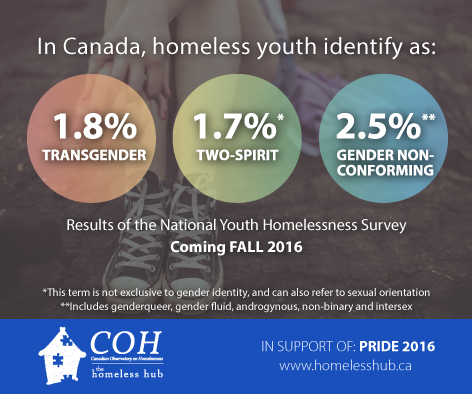The Canadian Observatory on Homelessness would like to issue a correction to an infographic that was released on our social media sites in June 2016.
In the fall of 2015, the Canadian Observatory on Homelessness, in partnerships with A Way Home and the National Learning Community on Youth Homelessness, launched a large-scale survey of youth experiencing homelessness. Throughout October, over 1000 youth generously shared their experiences.
As a result, we have amassed an unprecedented amount of data on the causes and consequences of youth homelessness and have gained a better understanding of the unique experiences that youth face.
In fall 2016, we will launch the full results. In advance of the release, we are releasing snapshots of interesting and unexpected findings. In recognition of Canada’s first-ever Pride Month, we published an infographic that overrepresented the percentage of young people who are homeless and transgender. We should have used the term non-Cisgender.
The term Cisgender refers to a person whose self-identity conforms to their birth sex. While it is true that over 6% of the youth in our survey reported being non-Cisgender, this is not the same as being transgender. In our analysis, we incorrectly grouped together individuals who are transgender (1.8%) with those who are Two-Spirit (1.7%), and gender non-conforming (2.5%).
Based on consultation with others, we’ve since revised our infographic to ensure that it accurately reflects the data and promotes a better understanding of LGBTQ2S homelessness, rather than hinders it. All of this underscores the importance of partnering with individuals from the LGBTQ2S community throughout the research process – from survey design, to data collection, to the interpretation of results.
We were encouraged to see a number of people promoting the original infographic. We ask that you circulate the revised infographic with the same fervor. While we know that LGBTQ2S youth are at greater risk of homelessness and victimization due to homophobia, transphobia and a lack adequate services, we were saddened to see such a staggering overrepresentation of youth that identify as transgender, Two-Spirit, genderqueer, gender fluid, androgynous, non-binary and intersex.
Fortunately, there are individuals and organizations across the country working to end LGBTQ2S youth homelessness. We hope that data collected through the National Youth Survey and other research will bolster these efforts. For more information on solutions to ending LGBTQ2S homelessness, refer to the following resources:
- LGBTQ2S Toolkit
- Blog Post: Taking Pride in Creating Authentic Spaces for LGBTQ2S Homeless Youth
- Blog Post: Recommendations and suggestions for how to prevent homelessness amongst LGBTQ2S young people in Canada and across the globe
- Ask Me (us) Anything! LGBTQ2S Youth Homelessness with Alex Abramovich and David French


